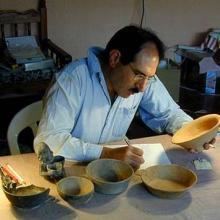Residence United States Role Archaeologist Citizenship American Alma mater Graduate Center, CUNY | Fields Archaeology Name Gary Feinman | |
 | ||
Known for Mesoamerican early state formationarchaeological survey and excavation in the Valley of Oaxaca, archaeological survey in Shandong, China, Books Images of the Past, Images of the Past with PowerWeb | ||
Gary M. Feinman (born 1951) is an American archaeologist, and the MacArthur Curator of Mesoamerican, Central American, and East Asian Anthropology at the Field Museum of Natural History in Chicago. He was a part of the Valley of Oaxaca Settlement Pattern Project which focused on the evolution of the Monte Albán state and shifts in settlement in the region over three millennia. He has conducted research in the Valley of Oaxaca, Mexico for over 30 years, most recently in the lands of the communities Tlacolula, Mitla, Matatlán, and Ejutla. These studies focused on household excavations at three sites (Ejutla, El Palmillo, and the Mitla Fortress). Most recently, he has begun excavations at Lambityeco in collaboration with representatives of the Mexican Institute of Anthropology and History. At Lambityeco, Feinman and colleagues have documented a large Classic-period ball court, which was not previously recorded during surface mapping of this site. The Field Museum of Natural History team also found the largest carved stone ever recovered at this site.
Since 1995 Feinman has also been conducting archaeological survey in coastal Shandong Province, China in conjunction with Shandong University. The coastal Shandong settlement pattern research, spearheaded by Feinman, Linda Nicholas (Field Museum), and Professor Fang Hui (Shandong University) has had a role in introducing this regional-scale systematic field methodology to Chinese archaeology. The team has documented a large segment of the ancient Qi Great Wall, which was built during the Warring States period, and ultimately was breached by Qin armies just prior to the first unification of China.
Feinman is the author of numerous articles, books, and book chapters. He is the founding co-editor of the Journal of Archaeological Research, past editor of Latin American Antiquity, and a Fellow of the American Association for the Advancement of Science.
Contributions to Archaeology
Feinman helped to develop full coverage survey methods, which he and colleagues applied to the Valley of Oaxaca to help understand the evolution of the Monte Alban state The particular method developed by Feinman and colleagues Richard Blanton and Stephen Kowalewski influenced a generation of archaeologists and are still widely used today. Feinman continues to employ and refine this method in his ongoing work in the Valley of Oaxaca and Shandong Province, China.
Feinman was an early proponent of world-systems theory, and actively applied it to the evolution of Mesoamerican and Southwestern US polities. Although this work was criticized at the time, it was further developed and employed by many scholars.
Feinman also helped to develop dual processual theory, which has had a broad impact in American archaeology.
Recent studies, underpinned by a career of regional survey and residential excavation, has offered new perspectives on prehispanic Mesoamerican economies, in which most production for exchange was undertaken in domestic contexts and marketplace exchanges had a central importance. This model is markedly different than prior perspectives that presumed centralized/administered production and exchange. In addition to drawing on results from survey and excavation, Feinman, in conjunction with Linda Nicholas, Mark Golitko and colleagues from Mexico and the United States, has begun an effort to greatly increase the quantity of sourced obsidian from documented prehispanic contexts in the Valley of Oaxaca.By combining these newly sourced sets of obsidian data from Oaxaca with a larger archive of sourced obsidian from across prehispanic Mesoamerica, Feinman and colleagues have documented significant shifts in networks of exchange over time, while casting further doubt on extant models that presume the prevalence of state-controlled economies and redistribution.
Feinman is the co-curator of two permanent exhibitions at the Field Museum, the Ancient Americas and the Cyrus Tang Hall of China). He also served as curator for a number of temporary exhibitions, including Chocolate, The Aztec World, China's First Emperor and His Terracotta Warriors, and Mexican Nativity Scenes.
